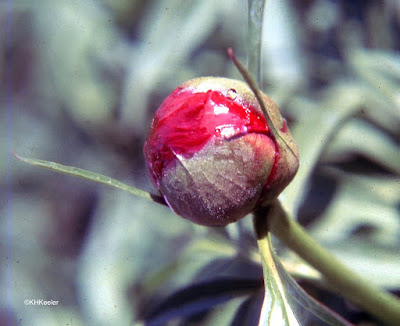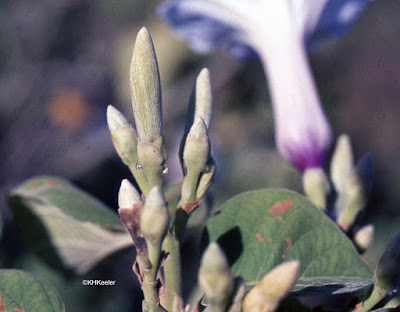 |
| Ants taking nectar from peony extrafloral nectaries. |
 |
| Drop of nectar on peony bud (upper right) |
There is no definitive answer to that question, but, based on studies of other plants, to attract ants which defend the plant from damage.
Nectar (sugar water)-producing glands on plants are called nectaries. Flowers frequently contain nectaries, providing nectar as the food that pollinators seek and in the process pollinate the flower. A nectary on a bud can't be part of pollination because the flower isn't open yet (photos above). Such nectaries are easier to observe than to understand. They are called extrafloral nectaries. The term is a little awkward but the idea is that they secrete nectar but are not part of pollination.
What do they do? In most cases where they have been studied, they are part of the plant's defense against animals that would eat it (herbivores).
 |
| Ant on extafloral nectary at the base of the leaf of beach morning glory Ipomoea pes-caprae |
 |
| Extrafloral nectar drop on morning glory bud |
I expect that in the wild, in say, China, ants or other nectar-feeders protect the buds of peonies from attacking moth larvae, grasshoppers or other herbivores.
 |
| Look carefully: a bee and wasp are visiting the extrafloral nectaries on this peony |
My Ph.D. research was done in Costa Rica, investigating the function of the extrafloral nectaries on the tropical morning glory Ipomoea carnea. Ants at the extrafloral nectaries on the outside of the flowers (see above) reduced damage to both flowers and seeds compared to plants without ants. Mine is one of the studies that show nectary-visiting ants provided the plant with protection from herbivores.
 |
| Shiny drops of extrafloral nectar below the buds on the tropical morning glory Ipomoea carnea |
Marjorie Weber, now of Michigan State University, and I analyzed the patterns in my World List of Plants with Extrafloral Nectaries a few years ago...it was great to use powerful computer analysis to identify patterns in a data set I'd been creating for more than 30 years. Of course, I'd published similar analyses in the distant past, and as we learn more and develop better tools, no doubt in the future someone will update our analysis. That's part of the fun of scientific research.
 |
| Extrafloral nectaries on the flowering stalk of Sansevieria |
That we only infer what is going on is in fact very common. There are an estimated 325,000 flowering plants. Most of them have never had anyone study anything about them. So we generalize from the few careful studies of pollinators or root growth or nutrient uptake or... I know there are thousands of studies of many topics, the problem is when you ask about a particular plant in a particular place often the answer is "hasn't been studied." The best we can do is to assume that the results of similar studies answer the question. Usually we are right but every so often we get a surprise. Biologists love those surprises, because they teach something new about nature. So forgive me if I enjoy hedging about peony extrafloral nectaries: "Why do peony buds secrete nectar? There is no definitive answer to that question, but, based on studies of other plants, to attract ants which defend the plant from damage."
Look at nature and wonder about what you see!
Comments and corrections welcome.
References
Keeler, K.H. 1977. The extrafloral nectaries of Ipomoea carnea (Convolvulaceae). American Journal of Botany 64: 1182-1188.
Mizell, R.F. 2001. Many plants have extrafloral nectaries helpful to beneficials. link (Some photos, from Florida). Weber, M. G. and K. H. Keeler 2013. Phylogenetic distribution of extrafloral nectaries in plants. Annals of Botany. 111:1251-1261 link
Winnable, R. 2012. Ants and extra-floral nectaries. Worcestershire Record. 32: 18-19. Link (Photos, from England)
Kathy Keeler, A Wandering Botanist
More at awanderingbotanist.com
Kathy - what an interesting topic! By the way I try clicking through to view the world list and I got a 404 error. I don't know if that has to do with the iPhone or if the link is actually broken.
ReplyDeleteJust a few weeks ago Dave and I were watching as bees were seemingly feeding from the outside of Iris blooms. Are iris some of the flowers with extra floral nectaries? We couldn't figure out why they were visiting the outside of the blooms instead of the inside.
Monica, I see what you mean about the World List. I've asked the host about that. Yes, likely extrafloral nectaries on the iris but some bees will rob a flower, piercing a hole from the back to drink nectar if they don't fit into the flower the proper way.
ReplyDeleteLove learning about it and love extra detail!
ReplyDelete